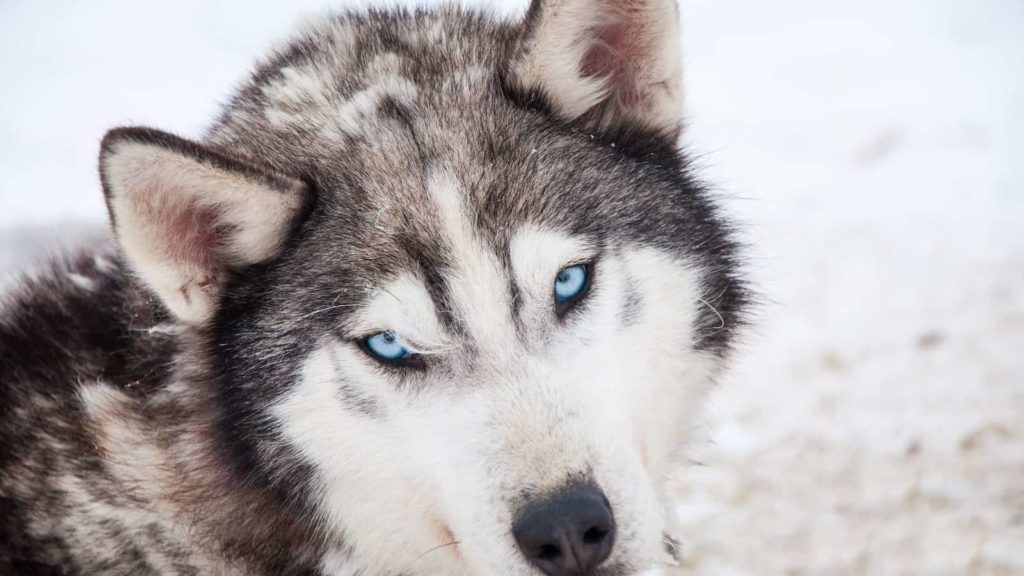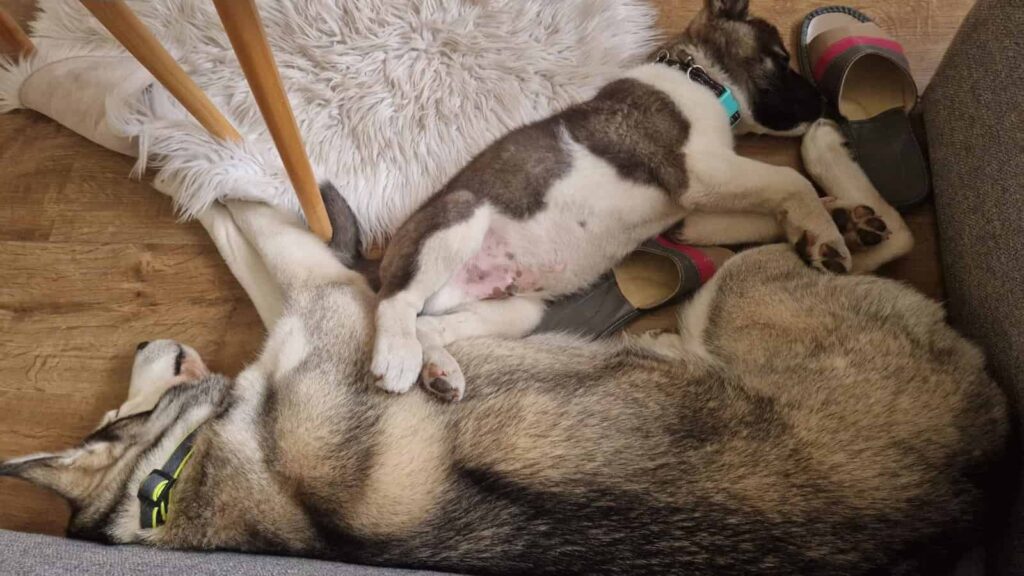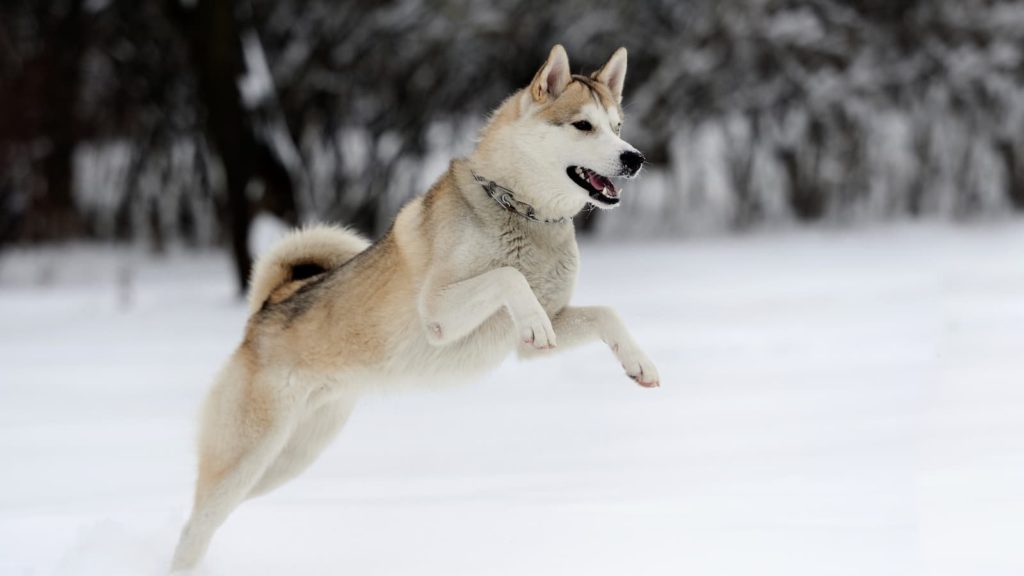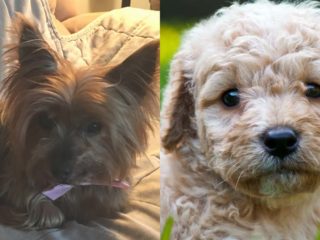If you have ever seen a wolf, you may have wondered why they look very similar to certain domestic dog breeds.
Although dogs and wolves are the same species, there are certain attributes of each that are quite different. Their ways of living over time are what have caused these changes.
One of the biggest differences between dogs and wolves is their teeth. Not only are wolf teeth much larger than dog teeth, but they are used for many different tasks as well.
If you are interested to learn more about what makes dog and wolf teeth alike, different, and unique, keep reading!

Difference Between Dog and Wolf Teeth
Some people who are familiar with dogs know that they are closely related to wolves. It is easy to notice a resemblance between certain dog breeds, like the Husky, and a wolf.
While some dog breeds do look similar to wild wolves, there are many differences between the two, the biggest difference being their teeth.
Dog and wolf teeth are located in the same area of the mouth and serve many of the same purposes as the other. The main difference is the size of wolf teeth, they are usually much larger and longer!
Disclaimer: This post may contain affiliate links. We only recommend high-quality products that are used and recommended by real owners. If you use these links to buy something we earn a small commission.
Other than size, a dog’s and wolf’s teeth are the same. They have the same number of teeth — 28 as a puppy, and 42 as an adult and they also use them for some of the same tasks, such as eating.
Dog Teeth Vs. Wolf Teeth Size
When compared with a dog, it is easy to see that a wolf is much larger, especially when you take notice of its teeth.
The size of a wolf’s canine teeth is much larger and sharper in comparison to a domesticated dog. Wolf fangs are normally around 1 ½ inches long and can sometimes reach 2 inches or even longer. A dog’s canine teeth reach around 1 inch at their longest.
As wolves’ way of living changed over time, and breeding occurred more often, domesticated dogs appeared, and their features slowly changed to adapt to their new ways of life.
Note: If you are thinking of getting a Husky check out this article. First dog? Don’t get a Siberian Husky
Wild wolves in today’s time still maintain the appearance of traditional wolves, whereas domesticated dogs have changed significantly into all the different breeds we currently have.
As stated above, wolf teeth are much larger than dog teeth because they need to be able to crush through material that is harder than what a normal dog would be eating.
While wolves are using their teeth to catch prey, eat, and digest their food all on their own, a dog is using their teeth for chewing soft, pre-made, and often store-bought dog food that is made specifically for dogs, or even for a specific type of dog breed it is, as well as chewing on toys/dog bones.
NOTE: Dogs are able to get all of their nutrients from their dog food while wolves are getting it from the bones of the animals they catch (or in some cases, from plants and other things in the wild). Their teeth must be long and sharp in order to get to the nutritious parts of the bones.
Wolf’s teeth are made specifically for attacking prey, especially larger animals such as bison, caribou, cattle, deer, etc. Domesticated dogs aren’t going to be going after animals like these.
Take into consideration a wolf, who lives in the wild, vs. a dog who lives in a city, town, etc. that is usually spending time in a yard or a house. The wolf needs more complex teeth to be able to get food and after, chew and digest it.
A dog’s teeth would not be able to bring down an animal of large size, their small mouths and shorter teeth would not do them any good.
NOTE: Wolves also have larger heads, mouths, and teeth for the sole purpose of being able to live on their own, in the wild, and get the food and resources they need to survive.
Some of the teeth within a dog and wolf’s mouth are the same, the main differences are the canine teeth (fangs) and the molar teeth. A wolf’s canine and molar teeth are much longer and thicker than dogs.
It is important to note that dogs will typically have their food at a certain time of the day, wolves are able to go days without eating after having a very large meal.
Although wolves may not be eating as often, their teeth and mouths are still doing a lot of work on one meal. Dog teeth aren’t used for as many different tasks as wolf teeth are, this is why wolves tend to have much better teeth health than dogs.
This is also why it is so important for domesticated dogs to upkeep their dental health (by chewing on bones, eating certain dog food, etc.)
NOTE: If a dog owner is concerned about their dog’s dental health, it is best to visit the vet who can make a plan that will improve the dog’s teeth, gums, etc.
Benefits of Dog and Wolf Teeth
Like humans, dogs, and wolves both benefit from having teeth; however, teeth are more essential for survival when it comes to wolves.
Both dogs and wolves benefit from having healthy teeth. They can eat properly, and digest better if their teeth are in good condition. One of the main reasons having teeth is important for dogs and wolves is because it simply makes life easier!
Teeth aren’t necessarily needed for a dog’s survival if they are living at home, only staying in the yard, inside, or with their owner.
There are a lot of dogs that have to have their teeth removed because of dental issues, thankfully there are soft dog foods (wet and dry) that a dog with no teeth can have.
A lot of smaller breeds suffer from teeth crowding and end up having their teeth pulled. (This is common for breeds like Yorkies, Maltese, and Pugs.)
One of the main benefits of having teeth for a domesticated dog is that they are able to chew foods better, play with toys, and also maintain their dental health because they are able to chew on bones, have their teeth brushed, etc.
NOTE: It is recommended to have a domesticated dog’s teeth cleaned at least once a year; twice a year if the dog is prone to having buildup on their teeth or dental issues.
The situation is different when it comes to a wolf, who needs their teeth in order to survive each day; they are necessary for a wolf to catch and eat food, without them getting food would be a huge struggle.

Dog Vs. Wolf Teeth Health
A lot of dog owners would assume that a domesticated dog would have better teeth and gum health compared to a wolf; however, this is not the case!
Wolves tend to have overall better appearance, condition, and health for their teeth, more so than dogs. Because they are constantly using their teeth, they are also less likely to develop dental disease.
Domesticated dogs are more likely to lose teeth and experience fractures and sores within the mouth because they are not strengthening the teeth consistently and using their mouths as much as wild wolves are.
Dogs are also known to develop gum disease because of bacterial infections in the mouth. Wolves can still get gum disease, but they are much less likely since they are consistently cleaning off their teeth with everyday activities in the wild.
While wolves do have overall better dental health than dogs, they can also still develop infected or ulcerated teeth/gums. Because they oftentimes have to chew into harder objects, they are known to have teeth breakage.
NOTE: Tooth breakage can lead to infection because bacteria will find its way into the broken tooth, this can be especially difficult for wild wolves because they aren’t able to visit a vet and get medicine for the infection like a domesticated dog would.
Are Dog/Wolf Teeth Sensitive?
Have you ever wondered if your dog is experiencing tooth sensitivity like a human can? The truth is that yes, they can!
Like most all animals, both dogs and wolves can develop sensitive teeth. This can be caused by a lot of different reasons including gum issues, hygiene of the mouth, broken teeth, diet, etc.
Something as simple as getting some food stuck in between the teeth can cause both a dog’s and wolf’s mouths to develop sensitive teeth.
TIP: If you notice your dog is having teeth sensitivity, it is best to take them to the vet where they can have an oral exam and be given the necessary treatment.
Diet is also a factor in whether or not a dog/wolf will develop sensitive teeth. A wolf will usually develop sensitive teeth because they are constantly biting down on hard objects.
Wolves use their teeth for so many tasks, it is no wonder they can develop sensitive teeth so quickly.
Dog Bite Vs. Wolf Bite/Bite Force
Since dogs and wolves are very similar, you may be wondering what the difference is between their bites?
When it comes to the bite of a wolf vs. a dog, there is a big difference. Wolves can kill prey with one bite, whereas it would usually take a dog more than just one bite to kill their prey.
A large wolf has a bite force of around 1,500 pounds, compared to larger dog breeds which have a bite force of around 300-500 pounds, and small breed dogs with a bite force of around 230–250 pounds.
Some people believe that dogs won’t usually kill their prey because they are so used to a history of hunting with humans, perhaps they know to catch the prey and not to kill it because the training is engraved in them from their breed history.
NOTE: Wolfs can be trained just like domesticated dogs can; however, even though they are extremely intelligent, they are not as responsive to training, and it can take more work/time for a wolf to be trained in comparison to a dog.

What Dog Breed Has the Worst Teeth?
Because dogs are so closely related to wolves, it is interesting to see how much they have changed over time, especially their teeth.
There are several dogs known for having the worst teeth among all dog breeds. Three dogs that are known for having bad teeth are the Chihuahua, Yorkshire Terrier, and Maltese.
Because these dogs have tiny snouts, jaws, and mouths, their teeth can become very crowded and end up needing to be pulled.
There are also larger dog breeds that are still very similar to the wolf and have teeth that look the same as well. Here are some dog breeds with teeth that are the most similar to wolves:
- Siberian Husky
- Husky/Wolf Mixes
- German Shepherds
- Akita
- Shiba Inu
- Chow Chow
Why do Dogs and Wolves Lose Teeth?
Like most animals, dogs and wolves can lose teeth for many different reasons; however, both will also not grow back their teeth if they lose them during adulthood.
Dogs and wolves can lose their teeth for many different reasons including infection, disease, lack of cleaning, etc.
Typically, wolves will only lose their teeth from old age or if they have developed an infection, usually caused by broken teeth.
Dogs, on the other hand, are known to lose teeth for many reasons, here are the most common reasons why dogs will lose teeth:
- Injury
- Trauma
- Poor dental health
- Lack of teeth cleaning
- Disease
- Metabolic Disorders
- Poor Diet
Some dog breeds are more likely to lose their teeth faster than other breeds, here are some breeds that are known to lose their teeth more often:
NOTE: If you notice that your dog is losing teeth and you have been keeping up with their dental health, there may be an underlying health condition that is causing this, it is best to take your dog to the vet to see what could be causing their teeth to fall out.
Read These Next (All About Wolves/Wolf Mixes and Dog Teeth!)
Siberian Husky Teeth Complete Guide (Cleaning, Problems, and More)
Complete Guide to Caring for your Dog’s Teeth (With and Without Brushing)
While we strive to give the most accurate and helpful information about your pet’s health that we can, this article is meant to be informational only and not medical advice. Never disregard, avoid or delay in obtaining medical advice from your veterinarian or other qualified veterinary health care provider regardless of what you have read on this site or elsewhere.



